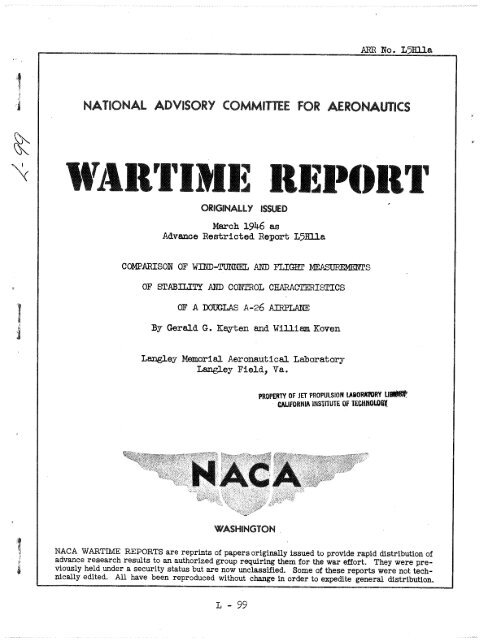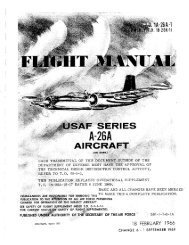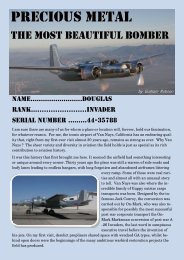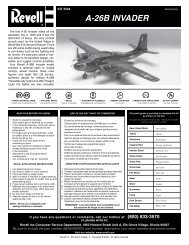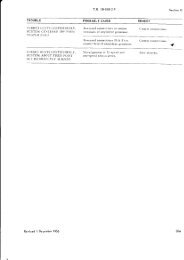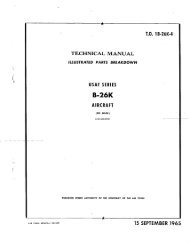Wind-Tunnel and Flight Measurements 2 - The Douglas A-26 Invader
Wind-Tunnel and Flight Measurements 2 - The Douglas A-26 Invader
Wind-Tunnel and Flight Measurements 2 - The Douglas A-26 Invader
You also want an ePaper? Increase the reach of your titles
YUMPU automatically turns print PDFs into web optimized ePapers that Google loves.
NATIONAL ADVISORY COMMBTEE FOR AERONAUnCS<br />
March 1946 as<br />
Advance Restricted Report L5Hlla<br />
COMPARISOI'? OF WIND-TUNNEL AND FLIGE -S<br />
OF STABILITY AND COrnOL CH,ARAcmISmcS<br />
By Gerald G. Kayten <strong>and</strong> William Koven<br />
Langley Memorial Aeronautical Laboratory<br />
Lmey Field, Va.<br />
NACA<br />
WASHINGTON<br />
PROPERTY OF JET PROPULSION LABORRWRY L<br />
CAUFORNU iNSTLTUTE QF TECHNOLO61<br />
NACA WARTIME REPORTS are reprints of papers originally issued to provide rapid distribution of<br />
advance research results to an authorized group requiring them for the war effort. <strong>The</strong>y were pre-<br />
viously held under a security status but are now unclassified. Some of these reports were not tech-<br />
nically edited. All have been reproduced without change in order to expedite general distribution.
HACA ARR No, L5Hlla<br />
8ATICNAI kD\rISORY COXIIqTTEE FOR AZ8OIUAUTICS<br />
----<br />
c o ~ P A ~ OF ~ S?gIJJ)- O ~ TciETEL A:% FLIGHT J { ~ A S U ~ ~ : ~ ? ? ~ ~<br />
Stability <strong>and</strong> control ckisracteri~tios determined<br />
from 'ccsts 5-r~ the Lz,lglsg 19-foot pressure tunnel of<br />
a 0.2375-scale mode! 02 t:ie Dou(~,laa XR-<strong>26</strong> zirplme sre<br />
compared sith those moaeurea in flight, tcs'cs of c<br />
Dou-glns A-<strong>26</strong>8 ai19piane i.<br />
Agreement raga.rding static 1ongitvZinal stai13-rillity<br />
as izdicoted by t h o el.evaJ~or-fixed neutral points <strong>and</strong> Sg<br />
the varletion of elevator deflection in both straight <strong>and</strong><br />
turning fllght was folnd to be good except at speeds<br />
apppoaching the stall. At these low s~eeds the airglene<br />
possessed noticea3ly lnprovod sta'fillity, which was<br />
attributed to pronou.ncod atalllng at thn root of the<br />
production ring. <strong>The</strong> procom.ced ~oot stalling did riot<br />
occur on the ssmooth, well-foired mocl~l viing. Elevator<br />
tab efFectivenes~ deterrninccl from modal tests agrzed ~flell<br />
~~ith fllght-test tab effectivenoso, but control-f orce<br />
varisttons with speed <strong>and</strong> acceleration were not in good<br />
a~rcginent, i?,l.l;hou:,h some discrepancy was introduced by<br />
absence of a seal on th2 model elevator ane 57 small<br />
diffeyences in the detenniaation of elevator deflections,<br />
coprelation in coxtro1,-f orco characteristics Vcas alsa<br />
influenscd by the effec-ts of fabric distortioi~ at high<br />
specs ;nd by small construction dj..ssirniLaritioa such as<br />
differenoes in trallfng-ed.ge angle. >&cspt for the vuavtioff<br />
condition, in ;.aich the tunn3l resuli;s indicated<br />
rudder-force reversal at a higl~r speed t11c.n the flight<br />
testa, agrecxenf in both rudder-fixed <strong>and</strong> rudder-free<br />
static directional stability was good. li:ociel arid airplane<br />
indioetions of stick-fixed <strong>and</strong> stick-frse dihedrsl<br />
offoct mere also in good agreement, althongh some dlfferenco<br />
in geometric dihedral may heve existed because of
2 XACA No. L5Rlla s<br />
wing 5ending in flLght. <strong>The</strong> use of model hinge-monent data<br />
obtained at zero sideslip ap~~eared to be satisfactory for<br />
the determination of aileron forces in sideslip. Fairly<br />
good correlation in tiileron effectiveness <strong>and</strong> control forces<br />
was obtained; fabrf c distortion 3ay hava been responsible<br />
to some extent for higher flf3ht values of aileron force<br />
at high sne'eds. Estimation of sideslip developed in an ..<br />
abrupt aiieron roll wzs fair, hu.t determination of the<br />
rudd.er deflection reqxiired to maintain zero sideslip in a<br />
rapid aileron roll was not entirely satisfactory,<br />
Althou:nec tion vvi tk the 4sarelo?ment of the ~ougias<br />
twir,-engine attac1.r bomber, a @&pies of investigations has<br />
been coneucted at the Lan4ley Laboratory of the XatFonal<br />
Advlsory Committee for ~ercnautics . <strong>The</strong>se investigations,<br />
the results of which hsve not been nu.blrPshed, included<br />
tests of a 0,2375-scale powered model of the XA-<strong>26</strong> airplane<br />
in the Langley 19-foot pressure tunnel <strong>and</strong> fl-ight tests<br />
of an A-<strong>26</strong>~ alr~lane. 537 use of the unnulnlished windtunnel<br />
data, calculations have 3een made predicting the<br />
flying qualitiss of the airalane for correlation with the<br />
cliaracteriatics meas~~red in the fli;;k~t tests. <strong>The</strong> results<br />
of the corre1at;ion are -resented herein; the flying qualities<br />
ars not discussed exce2t for the purpose of comparison,<br />
Thotographs <strong>and</strong> drawin~s of the A-<strong>26</strong>~ airplane <strong>and</strong><br />
the XA-<strong>26</strong> model are shown as fizurus 1 <strong>and</strong>. 2, respectively.<br />
In table I general dimensions ttnd specifications are shown<br />
for t.he airplane an?,. tbe model, as well as for the model<br />
scaled up to airplane size. Sone discre~ancies of neg-<br />
ligible importance &re noted in this table but it can be<br />
seen that, with respect to genorsl dimensions, the XA-<strong>26</strong> 4<br />
<strong>and</strong> the A-<strong>26</strong>.3 are essentially the same airplane. As shown<br />
e
iil fig- re 1, the model during 'tile stability <strong>and</strong> control<br />
tests was equipped with a fuselage rlose which was so,?;r;vha.t<br />
different f ro~n thzt of ths airgln~e, '<strong>The</strong> s~l-nners s:'?(~YIE<br />
, on the model proyellers were 1i0t 11sed on the aiy?la.ne, <strong>and</strong><br />
the airplane oil-cooler tiucts outhoard of the nacelles<br />
were removed fro21 .-the model wing clurinz the stabilLty <strong>and</strong><br />
control tesks with the exception of the aileron tests,<br />
Several more si~nificant differences existed between<br />
the :model an$. the cirplane . During most of the tunnel<br />
tests the :nodel n;l.dd.er <strong>and</strong> the elevator, which were of<br />
the pluin overhaqg -balance type, remained unsealed, Sut<br />
the airplane control surfac?~ :!"ere equipped with r~b'cerized<br />
cai?Lvas seals. 'I'he coiztrol sv.~>l"aces, all of which were<br />
faSric-covered on the airglaie, :sJere of rigid metal con-<br />
-<br />
s tru-ct ton on the mode 1. Yne al.r:?!_ane ailerons we re equipped<br />
witl: balancing taGs arrangsd so that 8' of alleron deflec-<br />
ti on produced ap?roximately 3O of o1;poslte tab deflection.<br />
On th.2 model i;he balancing tab when connsctad moved lo<br />
for a 10 aileron deflection.<br />
Thin m5tal strips ware fastaned to the up25r aiid lower<br />
surfacas of tb.e air~lane el,;? V- ~a-t~r causing srnall rl?.ges<br />
dirsctl;~ in front of ths taS. <strong>The</strong>se ridps were not<br />
re~3resented on the modsl, but their effect on elavator <strong>and</strong><br />
tab ~l~.a~acter;.is.'siss is belisved to be negligible.<br />
<strong>The</strong> wfnd-tunnel program included a fairly sxtensive<br />
series of conventional stability <strong>and</strong>. control tests. <strong>The</strong><br />
mod-el ailsron tests o nadc at a i?e)Tiiolds nU:nber of<br />
approximatel;? 5.h x 10 , <strong>The</strong> re!:iaining modal tests<br />
were xade at a Iieyfio1d.s aurn3e:r of approximatsly 3.6 x 10 6<br />
except for .the tests at high thru.s.i; coefficients, idvhich<br />
b.2cause of model motor lirii-tations i.vere made nt Reynolds<br />
numSers reciuced to anproxilnately 2.6 x 106. <strong>The</strong> portion<br />
of the fli?;ht tests devoted to sta.3llitg <strong>and</strong> control were<br />
of tks t~~l3e u~?.~~lly conductsd by the FZBCA for the Durpose<br />
oi' deteratning tha flying qualities of an air~lane, <strong>The</strong><br />
wei,$it of ths airplane, varied from 27,000 to 31,DOG<br />
~ounds in t!~e flight tests < was assi~.med for t3.e analysis<br />
of JChc ttunnel 6ata to 3s 20,000 pov.nGs corresponding to a<br />
wing loa8ing of 51.8 pounds per sq!l;ire foot, <strong>The</strong> analysis<br />
was based on an altltude of 10,000 fest, which rizpresehted<br />
an ap?roximate mean of the flight-test altftudzs.<br />
Analysis of the tunnsl data h ~ Seen s made for conditions<br />
rsp~?esenting ai rplar'e rated 3ovvar erld 75-perc~ilt<br />
rated power at the approprista airplane weight <strong>and</strong> eltltvdes
?JACA ARR No, LTBll a<br />
<strong>and</strong> fo? a gliding fligkt conditinl~. In represen'bation of<br />
the gliding t'ligl-;t co~id.ition, it has Seen assurnsd that s<br />
sngfnss-idling <strong>and</strong> zero-thrust conditions nay Se considered<br />
identfcsl. Any discrepancy in results introduced by the<br />
dii'ferei-ice between these power conditions probably vv-ill<br />
be -,small.<br />
In comnut ing clavator , aileron, <strong>and</strong> rudder control<br />
forces f rori model hinge-noment data, cor~esponding<br />
control li,nka:.es ., msasured on t3e air>larie were used.<br />
6c elevator deflection, dedrses<br />
6p flap deflection, dega3s<br />
6t t2b deflection, degraes<br />
Ch hhge-moment coef2'icient<br />
'i<br />
indicated srrspeed, miles per hour<br />
F e elevator control force, pounds<br />
- pb wing-tiphelix angle, radians<br />
2v<br />
whe re<br />
R hinge noment , foot-pounds<br />
S ming span, feet<br />
-<br />
c ~oot-mean-square chord, feet<br />
q d~pt;afc pressure, pounds par square foot
WACA ABR $Joe LjHlla<br />
P nass density of air, slugs per cubic foot<br />
V e.irsyeed, feet per second<br />
T total tnrust (two propellers), 7ou.nds<br />
D propeller diameter, feet<br />
P rollicg veloci tg, radi~ls per second<br />
S ~iiil?g area, square feet<br />
C, angle of attack, degrees<br />
a t.<br />
taail mgle of attack, degrees<br />
Q acceleration of qravfty, feet per second per<br />
s e cbnd<br />
1,ongitv-dina?. Stability end Control<br />
Curves of elevator mgle a;1d elevator control force<br />
required for trim fm straight flight t!~rougliout the speed<br />
range are shown in figure 3. 'Various fla13 <strong>and</strong> PoTtLyTer<br />
combinztfons are considered at three center-of-qravity<br />
1ocatkor.s. For the f'lsps-retracted conditf ons, the tunnel<br />
control-force cxrves were obtained by ap?lying th.e tab-<br />
effec-tiveness data of figure 1; to the tab-ne~trai curves<br />
es tI,-catec?. From the tu.rae1 hfnga-moment data. <strong>The</strong> axour;t<br />
o? tab deflectior: required to adjust the tunnel curve for<br />
trix at the flight-test trirr: speed was determfned for each<br />
nower condition snd center-of -g~.avf tj location, <strong>and</strong> this<br />
ar~ount. of t sb dei'leckion was a.ss~n:ed constant t!iroughou.t<br />
the sveed range. Inasriiuch a.s i~odel trj-m-tab teats were<br />
not ~ade wf th flaps deflected, the -i;rfrmiecl. control-f orce<br />
curves for this condition were obtained by Ilieans of a<br />
constmt adjustment to eack original curve of Ch<br />
against Thf s const ant henge-morneat shzf t is believed<br />
L'<br />
justified because the data of figure !, indicate a negligible<br />
change in tab effectiveness with change in pewer<br />
(f lans retracted) <strong>and</strong> because analysis of stabilizereffec.~iveness<br />
data indicates that the variation in<br />
average dyne~cic-pressure ratio with speed is small for
the f laps-def lected conditi:>n. <strong>The</strong> flaps-def lected ,<br />
control-force curves for zero tri:n tab are included in<br />
PS-gure 3.<br />
<strong>The</strong> sideslip requfred for stra.ight flight at low<br />
s2eeds was considerec! to have a negligible effect on the<br />
long1 tudinal characteristics or this airpl=le; hence, the<br />
characteristics determined fro~c tunnel data are based on<br />
tests at zero sidesli2.<br />
<strong>The</strong> variation of tab effectiveness with speed has<br />
been calculated from f laps-retracted wind-tunnel tests<br />
~nsde at elevator-tab settings of 3' <strong>and</strong> -5' with 6, = 0'<br />
<strong>and</strong> is sl.lo~vn in figure 1,. co~npared with the flight-test<br />
curve.<br />
Elevator def lecttons md control forces in steadjr<br />
turnlng flizht are ~ko~~lr~ in figures j to 7 for vzrious<br />
center-of -gravity locations. <strong>The</strong> calculated results are<br />
Sased or, tunnel tests at the tlvllst coefficient approximately<br />
corresponding to the appropri ate flight-test<br />
conditions.<br />
Althougli s 0m.e s~all d.if f ersnces exf s t in tile absolute<br />
elevatop engles, the slopes of the curves in figures 3, 5,<br />
<strong>and</strong> 7 show good agreement between tunnel <strong>and</strong> flight results<br />
for both straight md turning flight, except at speeds<br />
close to the stall. At these low speeds, the flight data<br />
shov~ pronounced inc.reases in the ?mount of up-elevator<br />
movement required for speed reduction in straight flight.<br />
<strong>The</strong>se marked increases are not apparent. in the tunr-iel data.<br />
Thfs discrepancy in results is believed due largely to the<br />
fac.t that the produ.ctfon airj21ane exhibited a decfdedly<br />
rnore deffnite stall at the 73~4r,g root tlxm did the smooth,<br />
polished nlodel., Althougi~ direct comparison of identical<br />
configura.tions f s not possfble, the ~ifference in stalling<br />
characteristics at the wing root is indicated by the diagrarils<br />
of "c;ln~el arid flight-test tuft studies shown in<br />
figures 8 <strong>and</strong> 9. <strong>The</strong> more ?renounced root stalling on<br />
the ai~plane would, in all ..>robabllity, be accomnanied by<br />
a reductfon in dovmwash <strong>and</strong> rate of downnash a.t the horizontal<br />
tafl as ell as a decrease in wing ~itc'ning noxnent,,<br />
resulting in =-I fu;prove;i;ent in stability <strong>and</strong> requfring<br />
.~reater up-elevator deflections for trln!. At liigher air-<br />
9 1 1<br />
speeds the agreement betwee;.: Plight <strong>and</strong> tunnel results is<br />
raeasons.bly consistent wf tn the experimenta.1 accuracy of<br />
both.
NACA ARR No. L5Hlla 7<br />
<strong>The</strong> tunnel <strong>and</strong> flight curves of elevator-fixed neutral<br />
poifit plotted against afrspeed fn figure 20 for the<br />
f lam-neutral conditions agree to within approximately<br />
2 percent of the mean aerod~jnamic chord except at low<br />
speeds with idling power. This difference is practically<br />
within the bounds of the experimental accuracy wlth which<br />
the flight <strong>and</strong> the wind-tunnel neutral points are determined.<br />
<strong>The</strong> discrepancy increases with reduced airspeed<br />
as the airplane demonstrates co~~~araJcively greater stability.<br />
Because of the ilifficulty in obtaining consist=nt neutralpoilrt<br />
result s, particu.larlg at very high airspeeds, neutral<br />
points were not determined for -tnese speeds. <strong>The</strong> curves<br />
of figure 3 serv3 as a mnensure of the stabflity in the<br />
high-speed range <strong>and</strong> are, in fact, believed more reliable<br />
for comparison throughout the speed range than the neutralpoint<br />
curve s. Alt3ough the curves for the f laps-d.ef lectzd<br />
coiidFtions are included for couplo-teness, direct comparison<br />
should not be made inasmuch as ti19 flag settings used in<br />
flight <strong>and</strong> tunnel tests were not Identical.<br />
Examination of the straight-flight control-force<br />
curves of figure j reveals comparatively poor agreement<br />
be tween tunilel <strong>and</strong> f 1-2 gkt results . Ths force measurements<br />
shown j.n the tab-effectiveness curves of figure 4, however,<br />
are in excellent agreement. 30th flight <strong>and</strong> tunnel contrcl-<br />
force measurements are believed to be accurate to within<br />
an:?roximztel;y t3 pounds. tilthou& some discrepancy in<br />
the elevator control-force cupves of figure 3 would be<br />
exnected because of the absence of a seal on the model<br />
elevator, analysis based on brief check tests in whfch the<br />
model elevator was sealed indicated that d.ifferencss of<br />
the magnitude shown in f'i;;ure 3 cannot be attributed to<br />
effects of the elevator seal. In an effort to determine<br />
the cause of the disagreem2nt, the effects of the discrep-<br />
ancies in elevator deflection xere investigated. Hy-po-<br />
thetical control forces were computed from tunnel hinge-<br />
moment data by using the values of elevator deflection<br />
determined from flight rather than thosa determined from<br />
tunnel data, For these computations, the wind-tunnel tab-<br />
effect.ivzness data were used, but the tab deflection was<br />
that employed in the flight tests. <strong>The</strong> curves obtained<br />
in tkis manner are shown in ffgure 11 compared the<br />
Plight-test data. In general, figreernent in fisure 11<br />
appears considerably improved; for several flight con-<br />
ditions, in fact, agreement is excellent up to speeds<br />
above 200 miles per hour, beyond 2vhich the flight-test<br />
curves become noticeably more stable. This difference<br />
may be explained to some extent by the observations of
elevator-f abric ciistopti on arid internal nressures made<br />
durfng the flight tests. <strong>The</strong> internal ..?resscre~ .were<br />
found to be only slightly higher than free-streaa static<br />
?ressure, causfns fa.brlc distortion of the ty?e 2ll.u~tratsd<br />
in fFgure 12. Az dsrlzonstrated in reference 1,<br />
eleva-bor-fabric distortion or" this tpe RaTT be e;zpected<br />
to pr~duce increases in the variatioa of force with<br />
airsneed at high speeds. Inasi~.uch as tine f laps-retracted<br />
flight-test triin speeds of figurs 3 =e all in this<br />
high-speed range, tne trim-tab ,
NACA A?? 1:o. L5Klla<br />
T?ie resosctive values of b~~d6.5~ <strong>and</strong> ysed<br />
in tkes2 coil!v)utatfons ;%ern -0.0037 cnd -0.~313 for che<br />
unsealed elevator an6 -6.0050 <strong>and</strong> -0.6052 for tkie seelsd<br />
elevator. <strong>The</strong> resultin2 curves of forcs :-)er ,g a);sinst<br />
center-of-pravity location are shoim in figure 1:. <strong>The</strong><br />
exve for the unseaied elevator is ~ractj.call:. ide~.tical<br />
wit? inat greviously determined fnr tzs unsealed<br />
el?vator (fi~. 7) by the met!loci of reference 2. For the<br />
seglea elevator the values 01' Torcs rer g 2re still<br />
vey- auch lower t -Ian tile f liqht- test values, a1 tiiou;h<br />
the vsriation of g with center-of -grsvit~- location<br />
is xors nearly narallel to tkat deternined in flight.<br />
<strong>The</strong> ccimarison of cqntrol forces in acceleratzd flight<br />
has beel-1 !;lade at a fairly high si?ee&. aeference 1<br />
in9ic8tes chat f aSrLc distcrtion of the type experienced<br />
iF1 the A-<strong>26</strong>~ f1i:ht tssts Kay be ex>ected to produce<br />
increeses in the vnriatfor, of force ~ ~ g i t iacceleration l<br />
in the nOPi a1 center-of -gravity range <strong>and</strong> in the<br />
v~irtinn of L'nrce -7er g wit21 censer-of-gravity<br />
location. This com:~arison as well as that for straight<br />
fli~i~t Tvvould alsc be influehcad by any ulf'ferer,ces in<br />
confrol-surf ace cons truccion,<br />
Agree~fient 5n the curves of elevator-free neutral<br />
aoint aga'nst airs-oeed (fig. 10(c) )is rather ?oar mi;<br />
becoiies worse PS the sneed increases. <strong>The</strong> flight-test<br />
e1svato~-free neutPal .,?oint Roves railidly reareard<br />
with increasing s~eed, 2nd st 1-1.igh speeds tiLe cir9lm.e<br />
a*,i3ears ;i:ore s tr.51~ with elevator free tl~ar. wltb levato tor<br />
fixed. It is believed t32t th;~ lapse reerwz:-d sk4ift<br />
in tke elevator-free neutral point sith increasin~ airsgeed<br />
clay be a result of the faSric distortion.<br />
In general, the present correlation indicates that<br />
su.ccessful ?rediction of elevr.tor control-farce characteristics<br />
from wind-tunnel data can he rna.de only if<br />
ex*cx?e care is used in rerresenting closely the airplane<br />
i.n its constructj.cn fcrm - particularly sith regard<br />
to. tne cont~ol surf aces. Agree~lient ~ 5th flight<br />
rtieasureicerzts aight also be improved considerably if<br />
-. eftects such as fabric -di~.+fidf~ri co~ald be taker, into<br />
- acsalmt,. A rrio-e beneficial solution, b.owever, would<br />
be to r~in.hnize these effects in the &~nstruction of<br />
the al.rpla~e.
La.te~ai 3tabi.lity <strong>and</strong> Control<br />
Steady .s.ideslip characteristFcs. - Cheracteristics<br />
r<br />
of thG1"rplane in. steady sideslips, which are used<br />
as flight-test r.easures of directional stability, ..<br />
direct1 onal control, dihedral eff sct, side-f orce<br />
chara.cteristi cs, <strong>and</strong> pitchirlg clonlent due tc sideslip,<br />
are skiotvn in figure lQ.. Although con;?lete hinge-nornent<br />
data for the model ail3rons md elevator v~e-e not<br />
obtained in sideslip, aileron forces in sideslip were<br />
estlmated from the tu.nne1 data by taking into account<br />
the change in effective angle of attack due to sideslip<br />
but a-ssiming no direct chakge in aileron hinge-rr~oment<br />
characteristic.^ with sides1i;s.<br />
For both idling a15 rsted-power flight with flaps<br />
retracted, f igure 1b si=ows excellsnt a.grnement in the<br />
variation of control se';tings, afiglc-: of Sank, <strong>and</strong> rudder<br />
force with sidesl.ip, elt'nouzh corm driffel.ence eriists<br />
in absolute values. Some of the difference in absolute<br />
values mag be due to the fact that nod el tare tests<br />
were not made in sideslip. It is especTally interesting<br />
to note the close agreemo~t Ln the variation of aileron<br />
crrgle with sideslip, which serves 9.3 ti flight-test<br />
indicatf or; of dihedral effect. ' It xas round in the<br />
flight tests .that the airplan3 ~iing En norrna.1 flight<br />
a??eared to bend u3ward noticeably with respect to its<br />
-position at rest. Despite the wing bending, however, the<br />
anount of effective dihedral determined from flight<br />
tests was also found to be no greater than that which<br />
would ordinarily be exyected for an sir?la.ne of this<br />
t:ype with 4.5' of geonetric dihedral. Analysis of the<br />
elastic properties of .tile model wing under load indicates<br />
that the ~iodel v~irig bending was neglizible. 3n t0.e basis<br />
of the agreement between xxodel <strong>and</strong> afrplme results,<br />
it a,-ipea.rs that tha observed airplme win^ bending nay<br />
have had very little effect in increasing the dfhedsal<br />
effect beyond the normal a~lount for 4.$O of geometric<br />
dihedral. Fu~ther ir,form;ltion regarding tl3.e ela.stlc<br />
pro2erties of the air2plane wing znd the effects of<br />
these 32roperties would have been desireble but wzs<br />
not ava.$l~.ble. Com~arfson of the flight <strong>and</strong> tunnel<br />
aileron-force curves e?.pears to indicate that little<br />
error was introduced in deternifnation of the latter by<br />
the assWi3ti on that aileron hinge-moment characteris tics<br />
rernainsd unaffected by sideslip. <strong>The</strong> sideslip characteristics<br />
vtitii flaL2s deflected do not agree as closely
NACA Al?R No. L5Hlla<br />
as do the flaps-retracted cbaracteri.stics, particularly<br />
in the case of the aileron-deflecti on rudder-Porce<br />
varf etions. <strong>The</strong> flight-test rudder forces s;iov? a tendgncy<br />
tovard reversal in figur~ 14(c) but do not actually<br />
reverse as in the case of the model forces. At an<br />
airspeed slightly lower t.km that for which! the data<br />
aye presented, however, r~dder-force reversal did appsar<br />
fn the flfght tests in this wzve-off condition.<br />
Dihed-ral effect with flaps def lecbed <strong>and</strong> rated power<br />
at low speed appears s0mewha.t lower in the tunnel<br />
:ne zsure:r~ents than ir, the f liglit data. <strong>The</strong> flap def lec ticn.,<br />
nowever, was 5C greater on the model than on the air-<br />
nlane.<br />
In figure 15, rudder hinge-moment characteristics<br />
estinia.ted from flight-test rudder kicks are conlpared<br />
wi th rudder hfnge-moment characteris tics rzeasured in<br />
the tunnel tests wltk flaps retracted. Although the<br />
model. rudder hinge-moiaent 2nd force results are foia an<br />
unsealed rudder aid are also sub jec$ to effects of small<br />
surf ace <strong>and</strong> trailing-edge irregularities 2s in the case<br />
of the elevator results, a.greement in this respect is<br />
good. As ~reviously shown in figure lk, the rudder<br />
forces lin steedg sideslip are In good aereement for<br />
thls flap condftion. In regard to rudder hinge mol~ients,<br />
the tunnel results which slnoivzd no aositfve values of<br />
the parsrneter zh,?? a for the rudder, indicated that no<br />
rudder snaking would occur in flight. This indication<br />
was confirmed in the flight tests.<br />
AEleron chsracterfstics. - No tu~nsl tests were made<br />
to investigate eileron characteristics for the 3 8 tab<br />
linksge wltli which the air.:?lar~e wa.s tested. If, liowever,<br />
linear tab eFfectiveness is assumed, these ciiaracteri sttcs<br />
for the flaps-retracted condition cm be estimated from<br />
the results of tunnel tests of the plain ailerons <strong>and</strong><br />
the ailerons with a l:l balancing-tab ratio. Estimates<br />
of control force <strong>and</strong> helix angle made in this nmner<br />
are comi3ared with flight measurements ir1 figure 16 for<br />
inufcated airspeeds of 135 <strong>and</strong> 383 miles per hour.<br />
As recoimilended in reference 2, helix angles vvere<br />
estimated as - pb - 0.8~~<br />
, where CZ is the total aileron<br />
2v<br />
ZP<br />
rolling-moment coefficient <strong>and</strong> a value of 0.57 was<br />
used aa the damping-moment coefficient C Although<br />
Z~ '<br />
11
12 NACA ARR No. L5Hlla<br />
the mgles of attack selected for these estimates<br />
corres;~ond to rated-power flight at the appro~riate<br />
speeds, the model aileron data wsre obtained in Foweroff<br />
static tests. Inasriiuch as the tunnel measurements<br />
were made for right rolls only, the. tunnel estimates<br />
are exactly syrmetrical fcr right <strong>and</strong> left rolls,<br />
whereas the fli3ht results are not. Agree~ent in the<br />
curves of !lelix argle is excellent in the range bv1
For the subject alrnlme; l~!hicl~ exkiibited essentla11~<br />
constz.nt 910329, %he fvnree irethods or" corr,:2utatloz baszd<br />
on y~lind- t?jnnel pasults 2:;3-:3e a? to L riij-3 very s il;lilap<br />
results w i t 3 res2ect 'to xa;c4.;,;u.:: sfdeslfi-, a;ri:-le, all 05'<br />
:I?I ;,ich<br />
L~ - a.Fe z,.-,~~oxir!e t3l.y. b0 hig5.e~ t:17,;1.:& the f If pht-tes t<br />
~rai~ne. bong tlie factors ~>ossibl:[ c.o:i-LribmtLn.2 to +' -ie<br />
lee? of ,-erfect agreel3er.t is t:!-Li-ie 2.iTferensa tet:~~irsen tile<br />
n<br />
instault8.zsous eo:~trcll del'lsctio'rl ass~c~ed , o- the ccli;p:lte.tions<br />
azd t,hs actuel control .iiove;~3nt in the flight<br />
test. Another rector infl~enci;i..- t.::~ results xay be the<br />
c!l?ent?.e Pn :lorrr?al ~.ccaler;;t,fan exrerl.snced by trle eii-plry;~<br />
in fts poll out of t?ie turn, Alt3.ou:c;h no flig,ht record<br />
of nornel acceleration v!es o%tai.rled Tor the test in<br />
qu~-estion, sl:nilar. f1i.r;-.t-test<br />
c ..JJ res1:lts iadlcate i;:?.at a<br />
considerable varPst.ion r~a~7 heve occu.rred during the<br />
;Yaceuver. Analysis fnc?.iccwt tix2t trle change in norxal<br />
acce1ers:;ion ~nd, col?seque:riti:;, Iff -t; eoei'ficlent ma.7<br />
intro5uce sonditioas conuideraS1y different from those<br />
considgred i.n the t,%eoretical. calcui?.tFono.<br />
li simqle static estil::ati= 05' the mount of rudder<br />
deflection required to rnpintain zaro sldesi~-~ . in en<br />
aileron roll was ~ade 2s su;;~ested in ~eference 2; that<br />
- .<br />
is, it b~jnjas ar.su;ned thqt tile 2esll-e:I yuddsr deflection<br />
would be thzt required to c,o?.mtarect tk13 combination or'<br />
af leyoli adver s s -yawing ~oicen t a.2.d p:.anrinp: a nioxent due to<br />
o l l n Ths estirriated va1-a~ oSta2ced by this rLet,hod :-;as<br />
;;":;,proxi~r~atelp 8" for fLa~p>s-~etr~cted f lirii1-t -- ?.;rit?l levelf'lfsht<br />
poi:vep s.$ en flid-jce-te,5. eiysunr- ,?: of i!:.'j i7.,iles ;?e$<br />
4 .<br />
;lour. Alt3ou55 no f lP
14<br />
MAC A ARR No. L5Blla<br />
0,2375-scale powered model of the <strong>Douglas</strong> XA-<strong>26</strong> airplane<br />
have been compared wlth results of flight tests of a<br />
<strong>Douglas</strong> A-<strong>26</strong>~ airplane,<br />
<strong>The</strong> significant results of the comparison may be<br />
summarized as ToZlows :<br />
I. Good correlation was obtained regarding elevator-<br />
fixed. neutrai points <strong>and</strong> the variation of elevator<br />
deflection ir: both stralght <strong>and</strong> turning flight except at<br />
speeds approaching the stall. At these low speeds<br />
the airplane showed a distinct improvement in stability<br />
not Ind.lcated bg the xiode1 kcsts, <strong>The</strong> differonce was<br />
attributed to the fact that the pronounced stalling a-t;<br />
the root of the p20duction ail>plane vting did not take<br />
place cn the smooth, well-faired model wing,<br />
2. Thc variatl.ons 3f 8levztor ~olitrol force with<br />
airspeed <strong>and</strong> acceleration wcro not in good agreement,<br />
Although some discrepancy was introduced by the absence<br />
of a seal on the mods1 elovator <strong>and</strong> by small diPferences<br />
in absolute values of ele;i..ztor doflcctbon, the correlation<br />
in control-force chzracteristica was also<br />
influenced by the effocts of.' fabric distorticn at high<br />
speeds <strong>and</strong> by small con.atr.ucStion. c?issimi?.arities such<br />
as differences in trailing-cdge angle.<br />
3. Elevator tab effectiveness as determined from<br />
t~anel. data was in good agresmcnt wfth Plight-test ta.b<br />
sffectfveness.<br />
It.<br />
Agreement in both rudder-fixed <strong>and</strong> rudder-free<br />
static direckional stab2li.t~~ was good except in the<br />
wave-off conditi-on, in which "iho model tests ind2cated<br />
rudder-force reversal at a higher speed than the flight<br />
tests.<br />
5. Model arid airplam indications of stick-<br />
fixed <strong>and</strong> stick-free dihedral effect were in good<br />
agreenzent , although son6 slight difference in geometric<br />
dillecral ma;y have exigtad because of wizg bending in<br />
<strong>Flight</strong>, <strong>The</strong> use of' model hinge-moment data obtained at<br />
zero sideslip appeared to be satisfactory for the<br />
Getermination of aileron forces in sideslip.<br />
6, Fairly good correlation in aileron effectivenesb<br />
<strong>and</strong> control forces was obtafned, Fabric distortion was
SelFeved res,)onsible to some extent for higher fl;ght<br />
values of' aileron force at high sneeds.<br />
7. Estfr;ia.tion of sfdesli:?! ~i1eveloy)ed in EZL zbru:?t<br />
aileron roll ws.s fair, but det,er~ninatPon of the ::iaxfii?ur;<br />
rlxiLder deflection required to zaint ain zero sideslip<br />
5.n ac. abrc.?t roll was not entirely satisfactory.<br />
Oil the basis of these f inlings, it aL3?ears that<br />
2cree:nent between stability md control cha.ractei?istics<br />
estiir:ai;ed fi-oi wind-tunnel rezults arid those iiie~.s;~recl<br />
in f'll,yht cannot be comm31eteQr- satisfac-Lory w:iess<br />
e4rZ;airl factors now usually neglec.i;ed in 1v;vfnd-tunnel<br />
t?stlns cp-9 be taxer! fiifvo co~si5eration. <strong>The</strong>se factcrs<br />
invclvs s;~,all differsnces betvieen t.he ~~iodel pad the<br />
air:~lene ~nd Include differences iri elastic :2roperties,<br />
surf ace finish, <strong>and</strong> construction accuracy. <strong>The</strong>se f'act,2rs<br />
* ,<br />
sbould be considered, i.t po::stbla, in futurs inve gtigations.<br />
Lar~gleg b:einori~l Aerori~utf<br />
cal LaSoratorg<br />
National AdvTsory Coi:,li:f ttee for Aelonautics<br />
Langley Field, Va.
3ACA ARR No. LrjHlla<br />
1. '*:atl,?sws, Charles V.: -An baiytical InvestigatLgn of<br />
the Tffects of Elsv2tor-Fabric Gistortion on the<br />
Longitudinal Stability <strong>and</strong> Control of an AI~3lane.<br />
FACA ACR lie. .&E~o, lfk.<br />
2. Kzyten, Gerald G. : A~alysis of urind-Ta!nel atability<br />
<strong>and</strong> Control Tests in Terns of Flying cdalfties of<br />
Full-Scale Airplanes. M,4CA ATE Eo. 3522, 19ic3.<br />
5 Jones, Robert T. : k Slrr,pfif ied Applicstion of the<br />
Yetho2 of Overators to the Calculation of Gis turSe -1<br />
:.'otions of an Air~lane. NA!ZA Re3. Xo. 560, 1556-<br />
4. iJlolowi.c~, Chester H.: Prediction of I,lotiolis of ar-,<br />
Ai r~lane Res:~l-t Png r'roix kbru.7 t ;?iovzlnen t of Lateral<br />
cr Directional Controls. NACA AR2 >To. L5EO2, l?ki5.
Sweepback of L.E., deg<br />
Incidence, root, deg<br />
Incidence, tip, deg<br />
Dihedral, deg<br />
Airfoil section, root<br />
Airfoil section, tip<br />
Wing flaps (double slotted) :<br />
Area (behind hinge line), sq ft<br />
Horizontal tail:<br />
Area, including fuselage, sq ft<br />
Incidence, deg<br />
Dihedral, deg<br />
Elevator area (behind hinge line), eq ft<br />
Balance area, sq ft<br />
Trimming-tab area, total, sq f t<br />
Distance elevator hinge line to<br />
25 percent M.A.C. of wing, ft<br />
Vertical tail:<br />
Area (excluding dorsal), sq ft<br />
Rudder area (behind hinge line), sq ft<br />
Trimming-tab area, sq ft<br />
Height above top of fuselage, ft<br />
TABLE I<br />
GENERAL DIMENSIONS AND SPECIFICATIONS<br />
NATIONAL ADVISORY<br />
COMMITTEE FOR AERONAUTICS
CA ARR No. L5Hlla Fig. la
NACA ARR No. L5Hlla Fig, lb
NACA ARR No. L5Hlla<br />
Fig. 2a
Fig. 2b NACA ARR No. L5Hlla
NACA ARR No. L5Hlla Fig, 3a
Fig. 3b<br />
NACA ARR N
NACA ARR No. L5Hlla<br />
Fig. 3c
Fig. 3d NACA ARR No. L5Hlla
NACA ARR No. LSHlla<br />
' /n d~ca fed airspeed, K, mph<br />
6qure 4 - Var~ation of ele va for trlm-tab<br />
effectiveness with ampee d .<br />
Fig, 4
Fig. 5 NACA ARR No. L5Hlla
NACA ARR No. L5Hlla Fig, 6
Fig. 7 NACA ARR No. L5Hlla<br />
Cen ter-o f-qrav~ fy /ocaf/on, percent MA. C.<br />
figure 7 - l/arlcut/on of eleva fw con fro/- force cmd def/ecf/on<br />
qf ~ci/ents w/fh cenrer-of-qmw fy /ocot/o/7. =<strong>26</strong>0 rn//es<br />
per hour of 10, 000- foo t a/f/f~de ; df=O; rofed powwj<br />
NATIONAL ADVISORY<br />
COMMITTEE FOR AERONAUTICS
NACA ARR No. L5Hlla<br />
Turbulent<br />
S talied<br />
V<br />
NATIONAL ADVISORY<br />
COMMITTEE FOR AERONAUTICS<br />
Fig. 8<br />
Figure 8.- Diagrams of stall progression in the gliding oondition.<br />
Engines idling; flaps <strong>and</strong> l<strong>and</strong>ing gear up; cowl flaps closed3<br />
oil cooler one-half open ; <strong>Douglas</strong> A-<strong>26</strong>B airplane.
Fig, 9 NACA ARR No, L5Hlla<br />
n<br />
j cross f/owin<br />
fbe dkct~on sfu#e Cofnp/efe/y d<br />
of or-fo ws<br />
n<br />
NATIONAL ADVISORY<br />
CUMMIiiEt FOR AERONKUTICS<br />
figure 9, - Bwer -offsf@//<br />
d/Ugriin?S forthe 0.2375 -sca/e mode/ of the XA -<strong>26</strong> o/rp/ane.<br />
Si'ondafd mode/ confi3ufot/on w/fh a/fp/une 011-coo/er ducts, Reyno/ds nu&, 4.25 x /O ;<br />
Mach number, 0./3/; Sf = 09
NACA ARR No. L5Hlla Fig. 10a
Fig. lob NACA ARR No. L5Hlla
NACA ARR No, L5Hlla Fig. 10c
Fig, lla NACA ARR No. L5Hlla<br />
/nd/ccufed wlrspeed, &; mph<br />
(cl) ficyp~ r-efrcuc7ed; ra fed power.<br />
bqure l'/ - hr~lat/on<br />
of elevufor con71-d force! w/fh<br />
ind~ccrfed mrspeed. Model elevator <strong>and</strong> tab deflec-<br />
Porn iden flccrl w/th fllqh 7- fes f set t/ncys.
NACA ARR No. L5Hlla Fig, llb<br />
- %<br />
(b)<br />
/OO /40 /80 220 <strong>26</strong>0 300<br />
/nd/cofed o~rspeed, 6, mmph<br />
flaps retracted; 75,oercent rafed poweE<br />
fiqure / 1. - Con flnued.
Fig. llc<br />
/ \ r\<br />
V<br />
,<br />
/<br />
1 - 0<br />
NACA ARR NO. L5Hlla<br />
---<br />
---<br />
A<br />
V<br />
/'/<br />
NATIONAL ADVISORY<br />
COMMITTEE FOR AERONAUTICS
NACA ARR No. L5Hlla Fig. 12<br />
I<br />
Y = 360 mph<br />
&=370 mph<br />
Gi d 28 percent ML -<br />
No- load h&ic tens~on, 2.7 /b<br />
--<br />
--- -<br />
4 = 270 mph<br />
- Sectlon under no load<br />
--___ Section ln fltghf<br />
Elevator ~ecfm<br />
822 in. from center //m<br />
of mrplune<br />
NATIONAL ADVISORY<br />
COMMITTEE FOR AERONAUTICS<br />
Figure /'. -€/e vo for- fahc d~forilon at<br />
various indcafed alrsped, Doug/as A<strong>26</strong> B<br />
a/rp/me wl f i cen fer of gravity a f 32 perrent<br />
A C excepf where nofed.<br />
r,
Cen~-er-of-qrav/ty /ocaf~on,percenf MA.C.<br />
NATIONAL ADVISORY<br />
COMMITTEE FOR AERONAUTICS<br />
FTgure 13-Vcrrlaf/on of e/evofor confro/-force gr~d/enf w/th<br />
center-of- grwv/fq /ocat./on esf/m w fe d for sea/ed md unseded<br />
e/evotors.Lf=<strong>26</strong>0m//e~ per hour at /O, 000-foof u/f/tude;<br />
df = 0 7 rofed power; s feady furn/r/y f//yh T:
NACA ARR No. L5Hlla<br />
Fig. 14a<br />
Control Tunne/<br />
Rudder - --<br />
E/evufor<br />
A~kron -<br />
(total)<br />
NATIONAL ADVISORY<br />
COMMITTEE FOR AERONAUTICS<br />
Leff &de//p ang/e?deg t?/ghf<br />
(a) &s re fructedj rafea' ,oo wer; & =/4/m//er per hou~
Fig. 14b NACA ARR No. L5Hlla<br />
20<br />
9<br />
8 o<br />
Q k<br />
j- 8<br />
\I I0<br />
Gf<br />
0" 20<br />
,.h<br />
c P lo<br />
2 Q<br />
figure 14. -Cont~nued.<br />
Control<br />
Turn/<br />
0 Rud&r ---<br />
0 Elevafor---<br />
El A//eron ---<br />
(t.ta/)<br />
(b) naps re frac f ed; T, =O ; @ =/33m//es pw hour.
NACA ARR No., L5Hlla Fig. 14c<br />
Con f ro/<br />
Fl/qh t Tunne/<br />
O Rudder - --<br />
0 Elevator - - -<br />
El A//eron -<br />
(tot 01)<br />
<strong>Tunnel</strong><br />
A fl~ghf<br />
NATIONAL ADVISORY<br />
COMMITTEE FOR A€RONAUTICS<br />
(c) flaps deflected; fated power; &=/I/ miles per hour.<br />
fiqure 14.- Concluded.
Lef~ Rlghf Left Rlq-ht<br />
chmqe ~n rudder de flec f.on, Chanqe ln J/~QJ//,o onq/e,<br />
deg ,AT, ADVtSORY<br />
COUUITTEE FOR AERONAUTlCs<br />
Fqur e - l/ar/lof/on of rudder hlnqe-momen f coefmenf w/th rudder de flec f~on<br />
<strong>and</strong> angle of s/des/lp of 1/;. =/40 m//es per hour. F/ops refrac fed. -
NACA ARR No. L5Hlla Fig, 16<br />
Left Change /n toto/ a~leron anq/e, deq R/gnt<br />
figure /6. - Varlcr7"lon of a~leron<br />
wheel i'orce <strong>and</strong> be//x<br />
mgle pb/ZV w/fh change ln 70 fa/ wl/ef-on ang/e /r,<br />
ro//s wi fh rudder fixed, flaps re trwc fed, <strong>and</strong> rcyfed<br />
power. NATIONAL ADvlsoRY<br />
COMMITTEE FOR AERONAUTICS
Fig. 17 NACA ARR No. L5Hlla<br />
-- -<br />
---- Reference 2<br />
Zme, ~ e c NATIONAL ADVISORY<br />
COHHITTEE FOR AERONAUTICS<br />
Flgur e / Z - Rol//nq ve/oc/ tl/ <strong>and</strong> s/des//p dur~nq. ader on<br />
ro// OUT of 30° banked turn. 6.=0°; 1/;-=/45m//es per<br />
hour uf/O, QOO-fwt a/t/fude ; /eve/ f//ghf poweE


